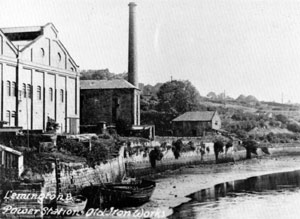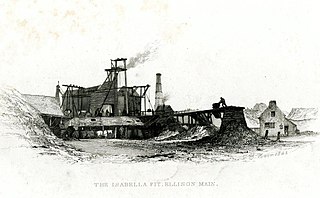
Newcastle upon Tyne, or simply Newcastle, is a city and metropolitan borough in Tyne and Wear, England. It is located on the River Tyne's northern bank, opposite Gateshead to the south. It is the most populous settlement in the Tyneside conurbation and North East England.

Tyne and Wear is a ceremonial county in North East England. It borders Northumberland to the north and County Durham to the south, and the largest settlement is the city of Newcastle-upon-Tyne.

Newcastle University is a public research university based in Newcastle upon Tyne, North East England. It has overseas campuses in Singapore and Malaysia. The university is a red brick university and a member of the Russell Group, an association of research-intensive UK universities.

The history of Newcastle upon Tyne dates back almost 2,000 years, during which it has been controlled by the Romans, the Angles and the Norsemen amongst others. Originally known by its Roman name Pons Aelius, the name "Newcastle" has been used since the Norman conquest of England. Due to its prime location on the River Tyne, the town developed greatly during the Middle Ages and it was to play a major role in the Industrial Revolution, being granted city status in 1882. Today, the city is a major retail, commercial and cultural centre.

Newburn is a semi rural parish, former electoral ward and former urban district in western Newcastle upon Tyne, North East England. Situated on the North bank of the River Tyne, it is built rising up the valley from the river. It is situated approximately 5 miles (8 km) from the city centre, 14 miles (23 km) east of Hexham and 13 miles (21 km) south south west of Morpeth. In the 2001 census, the population was given as 9,301, increasing to 9,536 at the 2011 Census. Newburn is in the Newcastle upon Tyne district of Tyne and Wear and is part of the parliamentary constituency of Newcastle upon Tyne North.

The North Eastern Electric Supply Company was responsible for the supply of electricity to a large amount of North East England, prior to the nationalisation of the British electricity industry with the Electricity Act 1947. The company was established as the Newcastle upon Tyne Electric Supply Company in 1889, but was renamed the North Eastern Electricity Supply company as it expanded to supply the North East region.

Hebburn is a town in the South Tyneside borough of Tyne and Wear, England. It was formerly in County Durham until 1974 with its own urban district from 1894 until 1974. It is on the south bank of the River Tyne between Gateshead and Jarrow and opposite Wallsend and Walker.

Dunston Power Station refers to a pair of adjacent coal-fired power stations in the North East of England, now demolished. They were built on the south bank of the River Tyne, in the western outskirts of Dunston in Gateshead. The two stations were built on a site which is now occupied by the MetroCentre. The first power station built on the site was known as Dunston A Power Station, and the second, which gradually replaced it between 1933 and 1950, was known as Dunston B Power Station. The A Station was, in its time, one of the largest in the country, and as well as burning coal had early open cycle gas turbine units. The B Station was the first of a new power station design, and stood as a landmark on the Tyne for over 50 years. From the A Station's opening in 1910 until the B Station's demolition in 1986, they collectively operated from the early days of electricity generation in the United Kingdom, through the industry's nationalisation, and until a decade before its privatisation.

Lemington Power Station was a small, now demolished coal-fired power station, located in North East England. It was situated on the Lemington Gut, a backwater of the River Tyne, at Lemington, 3.5 mi (5.6 km) west of Newcastle upon Tyne. The station's main building stood until 2017 as a rare example of an early power station, dating from before the nationalisation of the United Kingdom's electrical supply industry.

Carville Power Station refers to a pair of now partially demolished coal-fired power stations, situated in North East England on the north bank of the River Tyne at Wallsend. The two stations were built alongside each other on a riverside site about 5 mi (8.0 km) downstream of Newcastle upon Tyne. Carville A Power Station, the first station on the site was opened in 1904, and Carville B Power Station was opened in 1916 to its south.

Tyne and Wear is a metropolitan area covering the cities of Newcastle upon Tyne and Sunderland, as well as North and South Tyneside, Gateshead and Washington.
L. J. Couves and Partners were a British architectural firm from Newcastle upon Tyne in England.

North Tees Power Station refers to a series of three coal-fired power stations on the River Tees at Billingham in County Durham. Overall, they operated from 1921 until 1983, and the C station, the last on the site, was demolished in 1987. Billingham Biomass Power Station is to be built on their site.
Ottovale coke works was a large industrial complex situated at Blaydon Burn, near Blaydon-on-Tyne, Gateshead, North East England. The complex comprised a coke works, tar works and a power station. Built on the site of Dockendale Hall in 1904, it was operated by the Priestman Collieries until the 1970s.
Close Power Station was a coal-fired power station situated on Newcastle upon Tyne's Quayside, in modern Tyne and Wear. The station was built by the Newcastle and District Electric Lighting Company in 1902, near their Forth Banks Power Station.

Philadelphia Power Station is a defunct coal-fired power station situated between the villages of Philadelphia and Newbottle, 1.5 mi (2.4 km) north of Houghton-le-Spring in Tyne and Wear, North East England.

Pandon Dene Power Station was an early coal-fired power station situated on the Pandon Dene, to the east of Newcastle upon Tyne.

Whinfield coke works was a large industrial complex located near Rowlands Gill in Tyne and Wear, North East England. The complex comprised a coking plant, alloy factory and power station. Waste heat from the plant provided heat for a power station. This was later converted to generate electricity by burning coke.

Sheriff Hill Colliery or Ellison Main Colliery was a coal mine at Gateshead Fell in County Durham, England. The colliery had two shafts and provided employment to the residents of Sheriff Hill, after it opened in 1793. There were many major accidents resulting in the deaths of workers at the colliery. There was a protracted strike at the colliery in 1834. The colliery closed in 1926.
Chopwell Colliery was a coal mine situated at Chopwell, in Gateshead, Tyne and Wear. The pit was first sunk in 1781, and was closed on 25 November 1966. The colliery was bought by the Consett Iron Company in 1896, before being handed over to the National Coal Board in 1947, when the British coal industry was nationalised. The colliery's highest employment numbers were in 1921, when 2,185 people worked there.

















